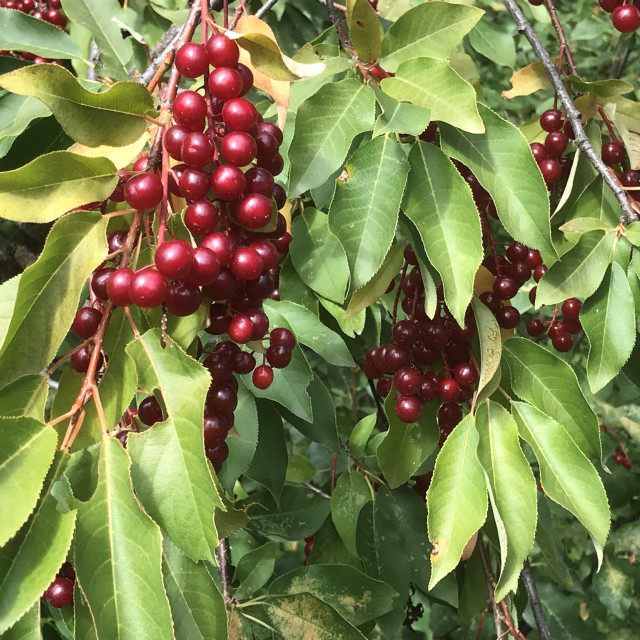COMMON NAME
chokecherry
SCIENTIFIC NAME
Prunus virginiana
ALSO KNOWN AS
common chokecherry
Plant family
Rose (Rosaceae)
Plant group
Deciduous Trees and Shrubs
Chokecherry is a perennial suckering shrub or small tree native to most of North America but introduced in Alaska.
1023 reports
183+
OBSERVERS
1023+
OBSERVATIONS
Identification hints
Chokecherry is distinctive in having flowers attached on stems forming long racemes. Most other cherries have flowers in short rounded clusters. In the Great Plains to the east black cherry (Prunus serotina) is similar in appearance. It can be a much larger tree up to 25 meters (80 feet) tall, and has sepals which persist with the fruits, has narrow leaves, and usually has brown to whitish hairs along the midrib on the lower side of the leaf.
Did you know?
There are eastern and western varieties of chokecherry. Chokecherry provided a staple for Native American tribes. Prussic (hydrocyanic) acid is found in the bark, leaves, and pits of chokecherry and there are numerous reports of cattle dying after eating these parts of the plant. The acid in chokecherry pits is neutralized by boiling or drying. The bark is used as a tea. The fruit is used to make jellies and jams. It has been used for a variety of medicinal purposes, including relief of diarrhea and sore throat.
DISTRIBUTION IN TH U.S.
Alaska
,
Arkansas
,
Arizona
,
California
,
Colorado
,
Connecticut
,
Delaware
,
Georgia
,
Iowa
,
Idaho
,
Illinois
,
Indiana
,
Kansas
,
Kentucky
,
Massachusetts
,
Maryland
,
Maine
,
Michigan
,
Minnesota
,
Missouri
,
Montana
,
North Carolina
,
North Dakota
,
Nebraska
,
New Hampshire
,
New Jersey
,
New Mexico
,
Nevada
,
New York
,
Ohio
,
Oklahoma
,
Oregon
,
Pennsylvania
,
Rhode Island
,
South Dakota
,
Tennessee
,
Texas
,
Utah
,
Virginia
,
Vermont
,
Washington
,
Wisconsin
,
West Virginia
,
Wyoming
HABITAT
Chokecherry is present in a variety of habitats and may become weedy. It prefers to grow in moist woodlands, along streams, in prairie hillsides, fence rows, rocky bluffs, and roadsides. It is mostly found on moist soils, but can be found in old fields, uncultivated field edges, and dry, exposed sites. It can also grow well on sandy soils. Chokecherry prefers full sun to partial shade and is intolerant of full shade.
ATTRIBUTES
Leaves
The leaves are alternate, oval-shaped, with fine teeth along the margins. They are glossy green on the tops and paler green underneath. Leaves start to emerge in early spring. Leaves start to change color to a yellow in August to September and have generally fallen/withered by the end of October.
Flowers
Flowers of the chokecherry are characteristic of the Rose family, with 5 white petals and many stamens. The small flowers are clustered in oblong racemes up to 5 inches long and emerge after leaves have already emerged.
Fruits
Fruits are drupes (fleshy fruit with a stone in the center) and are generally found in clusters. Small ripe cherries range in color from dark red to bluish-purple to almost black. When fully ripe, flesh of fruits are not poisonous, although their seeds contain high concentrations of hydrogen cyanide and are always poisonous.
Bark
Bark of young trees may vary from gray to a gray brown. Bark is distinctly marked by horizontal rows of raised air pores (lenticels) which develop into shallow grooves with maturity. The trunks rarely exceed 5 inches in diameter at breast height and often sucker heavily from its roots creating dense, clonal thickets.
Bloom Time
Chokecherry blooms April through July depending on location.
See Menu
- 2021 Chicago Botanic Garden. All Rights Reserved.
-
Creative Commons
BY-NC-SA 4.0 - Terms of Use
- Privacy Policy
- Data Sharing and Citation Policies
- 2021 Chicago Botanic Garden. All Rights Reserved.



